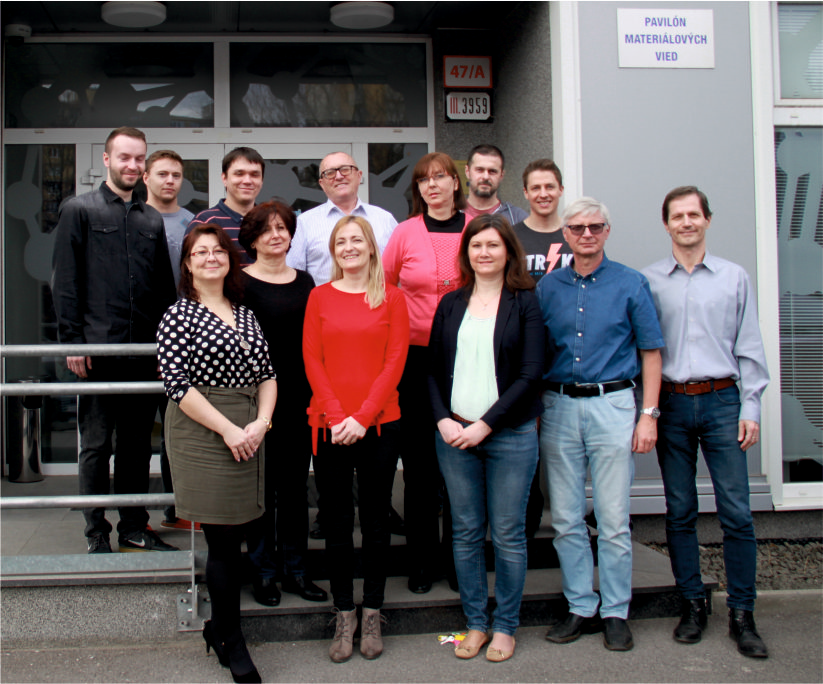Characteristic of division
The scientific-research activities of the divisions are focused on the research and development of ceramic materials, their composites and nanocomposites, nano/microfibers, ceramics of thin layers and coatings. In the area of research of ceramic materials, the main attention is given to the sudy of microstructure, determining the mechanical and functional properties of ceramics designated for advanced applications and to determine the relationship between technological approaches of preparation, microstructural parameters and the final mechanical and functional properties.
A great part of the activity is devoted to the development and implementation of modern methods and approaches connected with the preparation and testing of new materials at the nano and micro levels (SPS technology – Spark Plasma Sintering, Electrospinning – electrostatic spinning of polymers, PVD – Physical Vapour Deposition, SEM-FIB microscopy).

Characterization of materials
- Microstructure analysis – preparing samples with the aid of ceramography (grinding, buffing, etching).
- Preparation of thin foils for observation on TEM (pitting, ion bombardment)
- Light microscopy, scanning electron microscopy, transmission electron microscopy, AFM, statistical analysis of microstructural parameters, Raman spectroscopy.
- SEM/FIB microscopy provides: Two- and Three- dimensional imaging and analysis of conductive and non-conductive materials with the use of a local compensator charge. Preparation of ultra-thin laminations (<50 nm) for observation in TEM and conductive and non-conductive microstructures (< 20 nm) by way of deposition from the gas phase. Analysis of cross-sections and the structural interface of materials of thick layers and flaws in the material. Milling, bombardment, ionic etching of materials. Ionic lithography. Preparation of microforms (pillars) for the subsequent nanomechanical testing.
- Tests of mechanical and functional properties – testing in four-point bending / Weibull analysis, fracture toughness (IF, IS, SENB, SEVNB), indentation methods – hardness, fracture toughness, fatigue, electrical and thermal conductivity, etc.
- Tribology
- High-temperature characteristics of brittle materials (creep, thermal shock, oxidation); fractographic analysis of the flaws of brittle materials, prediction of the lifespan and dependability of brittle materials.
- Macro and microfractography, statistical analysis of fracture mechanisms.
- Nanomechanical properties – hardness, micro pillar, micro cantilever, scratch testing
In the event of questions, please contact us at: jdusza@saske.sk
Our main activities are divided into the following research areas:
A: Research of ceramic materials and composites
Development of progressive ceramic composites with carbon nano-micro structures (B4C, TiB2, ZrB2, SiC, Si3N4, CNTs – carbon nanotubes, GPLs – graphene platelets, etc).
Developing UHTC ceramics (Ultra High Temperature Ceramic – High Entropy Ceramics) for use in extreme conditions.
Preparation of materials by advanced sintering methods:
Sintering in the presence of plasma and ultra-rapid techniques with use of the electric field on the equipoment „spark plasma sintering“. There are possibilities of sintering materials with a ceramic or metal matrix, hardmetals, cermets, etc., in a vacuum at high temperatures, high pressures and short time periods.
B: Preparing thin coatings for engineering applications by PVD methods
The PVD laboratory is equipped with the newest PVD technologies for preparing hard, superhard, and alteratively functional coatings on the basis of one or several compenent systems, including nanocomposite, multilayer and gradient coatings, for engineering and other applications on the basis of HiPIMS (High Power Impulse Magnetron Sputtering) – magnetron sputtering by high-energy impulses on the basis of HiTUS (High Target Utilization Sputtering) – sputtering with a high efficiency target and an independent source of plasma.
C: Testing materials
Tribology: Examining tribological properties, such as friction coefficients, regimens and mechanisms of wear, especially with hard substances (ceramics, hardmetals, composites, alloys), but also with biomaterials, industrial materials, protective coatings and other substances. We arrange testing with various applications of loads, from 1 mN (nanotribometer) to 1 kN (universal tribometer with alterable geometry. In the geometry pin/ball-on-disk, there is possibility for tests at high temperature (800°C).
Nanoindentation and atom force microscopy:
Testing hardness, elasticity of other mechanical properties of coatings and other volume materials at the micro- to the nano- level. Examining the microstructures and topography of the surfaces, as well as some mechanical and magnetic properties using the atom force microscope with nanometric resolution.
D: Preparation of the nano/microfibers
Activities in this area of our research are focused on the development and characterization of polymer, ceramic and carbon nano/microfibers with the aid of technology of needleless electrospinning from the free surface of the solution of the polymer on the device NANOSPIDERTM NS Lab 200. This given technology enables us to:
– prepare continual, uniformly ordered fibers with an average 50 – 700 nm in the form of unwoven textile width to 350 mm.
– spin a wide spectrum of synthetic and natural polymers: PVA, PA-6, PAN, PUR, PEO, PVP, chitosan, collagen, PLA, PCL, HA…
– consequently from the precursor fibers produce ceramic oxide fibers – Al2O3, Fe3O4, TiO2, SnO2, ZrO2… or pure nanoparticle doped carbon fibers with controlled porosity.
 Contacts
Contacts Intranet
Intranet SK
SK